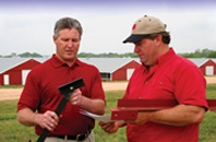Alfa Insurance Calls Poultry House Changes ‘Win-Win’

A change in poultry house construction standards required for insurability with Alfa will be a win-win for growers, lenders, integrators and insurers, according to Rex Seabrook manager of farm underwriting for Alfa Insurance, the largest insurer of poultry houses in Alabama.Poultry houses built according to the new standards, effective May 1, will last longer and be safer and stronger, said Seabrook. The changes will also help keep insurance affordable for policyholders and help growers with their long-term return on investment. Many houses built with inadequate construction standards seldom last longer than the mortgage without experiencing major structural problems. New minimum construction standards required for insurability mean minor changes for existing poultry houses, but much more stringent requirements for all new construction of houses. The changes also mean that two Alfa inspector/adjusters will work fulltime with growers. Before the changes were implemented, Seabrook met with the Alabama Farmers Federation poultry growers to get their input. “They asked us to find some things that would make the houses stronger and more stable, but wouldn’t be overly costly or put undue hardships on them,” he said. “That is what we have tried to do.” Although rates have increased slightly, they still are lower than they were 15 years ago, he said. “After talking with representatives of the poultry industry in several other states with better construction standards, we found they have far fewer structural problems,” said Guy Hall, director of the Alabama Farmers Federation’s poultry division.Under the new requirements, all new construction will require a copy of the structural plan for the entire house, clearly showing the specifications and the engineer’s stamp. The plans must meet a minimum load-bearing requirement of 31 pounds per square foot and be able to withstand winds of 80 to 90 miles per hour, depending on the location of the poultry house.New construction requirements also govern foundations, wind/hurricane strapping, roofing, electrical and gas. Firewalls will be required on adjoining structures, such as the egg room between two layer houses. The changes for new construction are estimated to cost an additional 3 to 4 percent on a grower’s investment, but Seabrook says the changes are beneficial to all. “If growers can avoid structural failures and make the houses last longer for a few additional dollars, that would be beneficial to growers and the entire poultry industry,” he said. The cost is even lower for existing houses. Existing houses have the option of being retrofitted with metal knee braces or paying a higher deductible. Braces must be installed connecting all trusses and side posts. Houses with metal trusses are exempt from the knee brace requirement.Existing wooden braces could be approved if they extend beyond the truss and are bolted to the side post. Mitered and toe-nailed braces are not approved because they are not as strong, said Seabrook. The braces help prevent a house from leaning during a storm and anchor the truss system, helping prevent major damage and loss of production for the grower. The deductible option is $1,000 for existing houses with knee braces and $2,500 the first year without a knee brace. The second-year deductible increases to $5,000. For year three and beyond, it rises to $10,000.Before beginning construction or retrofitting existing poultry houses, growers should contact their Alfa agent to be sure they meet new policy requirements.
